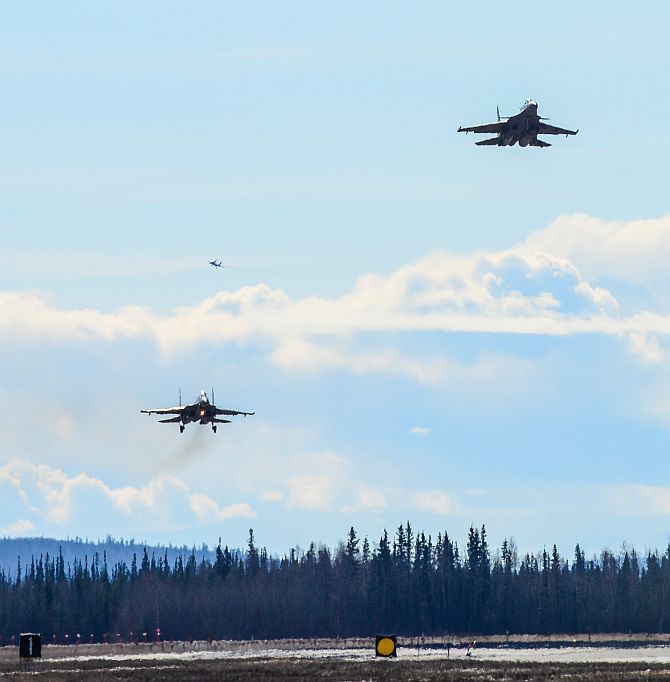 | « Back to article | Print this article |
The Indian Air Force's mainstream fighter aircraft, the Sukhoi-30MKI and Jaguar, are set to square off with their American counterparts to execute some of the most realistic manoeuvres of its kind during Exercise Red Flag over Alaska starting April 28.
Here's what you need to know...

-- The IAF contingent, comprising Four Sukhoi-30MKIs, four Jaguars, two C-17 Globemaster III transport planes and two mid-air refuellers Ilyushin-78, is being led by Group Captain H Assudani.
-- The contingent took the longest ever path to reach the Alaska air base -- flying via Bahrain, Egypt, France, Portugal, Atlantic Ocean and Canada. According to the 4 Wing Courier newspaper, the force took the long way as a test of their capabilities. "We were looking at this as a challenge, to go across the globe and deploy," team leader Group Captain Hirendra Assudani told the paper, adding, "With four different types of aircraft, the logistics and maintenance support of each aircraft is different from the others, so we wanted to challenge ourselves to go across the longer way."
-- This marks the second time that the IAF is participating in the Red Flag. Earlier in 2008, the Sukhoi aircraft had participated in the exercise at NEllis airbase. Due to high costs, the IAF had decided to take part in the exercise once every five years. It was scheduled to take part in the 2013 edition, but the exercise was cancelled by the US following budget cuts. According to an estimate, the 2016 exercise will cost India over Rs 100 crore. It will also see over 150 IAF personnel in action.

-- IAF pilots will be battling it out against the best men and machine combinations. The frontline battle machines of the IAF will be challenged by F-22 Raptors, F-18 Hornets and F-16 Falcons of the 353d Combat Training Squadron. On average, more than 1,000 participants and up to 60 aircraft deploy to Eielson during the two-week exercise
-- The Red Flag-Alaska exercises, certified as a Joint National Training Capability by US Joint Forces Command, normally involve a variety of interdiction, attack, air superiority, defense suppression, airlift, air refueling and reconnaissance aircraft. The 353d Combat Training Squadron integrates realistic combat scenarios, air and surface threats, state-of-the-art mission debriefing systems, and other contingency-specific training to provide combat and combat support training to military forces worldwide.

-- All Red Flag-Alaska exercises take place in the Joint Pacific Range Complex over Alaska as well as a portion of Western Canadian airspace. The entire airspace is made up of extensive Military Operations Areas, Special Use Airspace, and ranges, for a total airspace of more than 67,000 square miles.
-- Red Flag-Alaska participants are organized into "Red" aggressor forces and "Blue" coalition forces. "White" forces represent the neutral controlling agency. The Red force includes air-to-air fighters, ground-control intercept, and surface air defence forces to simulate threats posed by potentially hostile nations. The Blue force includes the full spectrum of US and allied tactical and support units. Because the Red and Blue forces meet in a simulated hostile, non-cooperative training environment, the job of controlling the mock war and ensuring safety falls to the White neutral force.

-- During the two-week employment phase of the exercise, aircrews are subjected to every conceivable combat threat. Scenarios are shaped to meet each exercise's specific training objectives. All units are involved in the development of exercise training objectives. At the height of the exercise, up to 70 jet fighters can be operating in the same airspace at one time. Typically, RED FLAG-Alaska conducts two combat training missions each day.
-- Red Flag-Alaska is a Pacific Air Forces-sponsored, Joint National Training Capability accredited exercise. Originally named COPE THUNDER, it was moved to Eielson Air Force Base, Alaska, from Clark Air Base, Philippines, in 1992 after the eruption of Mount Pinatubo on June 15, 1991 forced the curtailment of operations. COPE THUNDER was re-designated Red Flag-Alaska in 2006.
